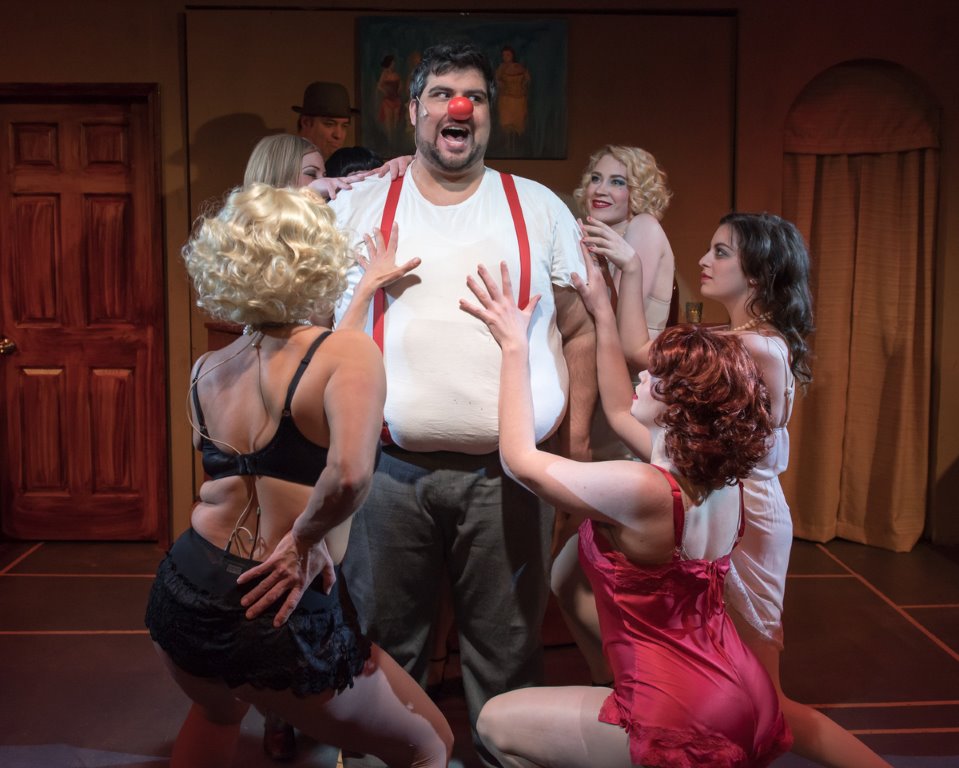‘Misery’ is both title and critique for Great Lakes Theater production
By Bob Abelman
Prolific novelist Stephen King earned his fortune terrifying his significant fan base with horror stories that feature shapeshifting eldritch monsters, walking dead abominations, demonically possessed cars and canines, and everyday folks cursed by supernatural abilities.
“Misery,” his 1987 novel that was turned into a 1990 film and a 2015 Broadway play, marches to a different demon: a middle-aged sociopathic bibliophile named Annie Wilkes.
The story begins with Annie finding an unconscious and mangled Paul Sheldon after he has run his car off the road in the midst of a rural Colorado snowstorm. Recognizing him as the writer of her favorite historical romance novels, she brings him back to her remote home for healing.
While there, she learns that Paul has killed off the novels’ main character, Misery Chastain, in his soon-to-be-released final installment so he can break out of his successful rut of writing pop fiction and become a serious writer of serious books. Keeping the paralyzed Paul prisoner, the unstable Annie uses increasingly extreme forms of torture in an attempt to get him to write a new novel that revives Misery Chastain and resurrects the series.
The stage adaptation of this psychological thriller is written by William Goldman – who also penned the 1990 screenplay – and has found a place in Great Lakes Theater’s seasonal lineup in the slot previously held by such like-minded works as Agatha Christie’s “The Mousetrap” and “And Then There Were None” and Frederick Knott’s “Dial M for Murder” and “Wait Until Dark.”
The thing is, Goldman does not have the skills or track record of a Christie or Knott. His first shot at a Broadway play, in 1962, lasted only 84 performances. “Misery” fared no better.
The play lacks the novel’s narrative voice, which assumes the point of view of the sympathetic victim of the horrific acts that King so skillfully describes and offers a carnival ride of suspense. It also lacks the cinematic storytelling afforded the B-movie rendition, which employed editing, camera placement and camera movement to establish its stifling sense of claustrophobia, create an atmosphere of fear and dread, and build immense dramatic tension.
Shock is so much harder to dole out and sustain in live theater.
To compensate, the Broadway production employed a revolving set that allowed the audience to follow the action from room to room exactly like a camera. And it offered a filmic underscore and cast highly recognizable film and TV actors Bruce Willis and Laurie Metcalf in the leads, to no avail.
Great Lakes Theater director Charlie Fee goes with more standard staging, with scenic designer Gage Williams building a farm house that is at once theatrically enticing in its detailed state of utter dilapidation and downright confusing in its placement of Paul’s room bizarrely in front of the rest of the exposed interior of the homestead. It is also dysfunctional in terms of the characters’ difficulty navigating the awkward layout and disappearing from sight in order to get from one side of the house to the other.
While lighting designer Paul Miller and sound designer Josh Schmidt do a nice job of establishing the raging snow storm that persists throughout most of the production, it is odd that the trees that surround the house show no evidence of inclement weather.
It could be argued that these creative choices reflect the state of mind of its insane occupant, in much the same way the castle crumbles in Edgar Allan Poe’s “The Fall of the House of Usher.” It could also be argued that all this is a distorted figment of Paul’s drug-altered imagination. But they wouldn’t be convincing.
A better argument is that all this is a conceptual misstep, a notion reinforced by the peculiar horror elements that are inexplicably and ineffectively incorporated into the play’s ending.
Andrew May, as Paul, is a fine actor tasked with portraying a terribly underwritten character. There is little this former Cleveland Play House leading man and GLT favorite son can do with his character’s limited mobility and curtailed dialogue to create the tension this play requires or provide the narrative voice the story so desperately needs.
For those unfamiliar with this tale, Kathleen Pirkl Tague is more than satisfactory as Annie. But for the rest of us, there is little she can do to avoid comparisons to actress Kathy Bates’ indelible screen incarnation and she does less to create her own memorable creature.
In short, this play is dull and a bit drowsy – two words rarely associated with Stephen King – and, to borrow from Annie’s limited but colorful vocabulary, this production is “cockadoodie.” It is easy to understand the commercial attraction of a popular work like “Misery,” but artistically, it seems a poor choice by the brain trust at Great Lakes Theater.
Great Lakes Theater’s ‘Misery’
WHERE: The Hanna Theatre, 2067 E. 14th St., Cleveland
WHEN: Through March 11
TICKETS & INFO: $13-$80, call 216-241-6000 or visit greatlakestheater.org
Bob Abelman covers professional theater and cultural arts for the Cleveland Jewish News. Follow Bob at Facebook.com/BobAbelman3. 2017 AP Ohio Media Editors best columnist.
Originally published in the Cleveland Jewish News on February 23, 2018.
Lead image: Andrew May and Kathleen Pirkl Tague. Photo / Roger Mastroianni











